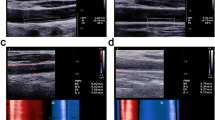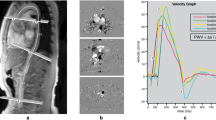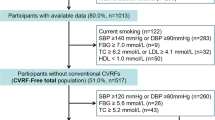Abstract
Arterial pulse wave velocity (PWV), an independent predictor of cardiovascular disease, physiologically increases with age; however, growing evidence suggests metabolic syndrome (MetS) accelerates this increase. Magnetic resonance imaging (MRI) enables reliable noninvasive assessment of arterial stiffness by measuring arterial PWV in specific vascular segments. We investigated the association between the presence of MetS and its components with carotid PWV (cPWV) in asymptomatic subjects without diabetes. We assessed cPWV by MRI in 61 individuals (mean age, 55.3 ± 14.1 years; median age, 55 years): 30 with MetS and 31 controls with similar age, sex, body mass index, and LDL-cholesterol levels. The study population was dichotomized by the median age. To remove the physiological association between PWV and age, unpaired t tests and multiple regression analyses were performed using the residuals of the regression between PWV and age. cPWV was higher in middle-aged subjects with MetS than in those without (p = 0.001), but no differences were found in elder subjects (p = 0.313). cPWV was associated with diastolic blood pressure (r = 0.276, p = 0.033) and waist circumference (r = 0.268, p = 0.038). The presence of MetS was associated with increased cPWV regardless of age, sex, blood pressure, and waist (p = 0.007). The MetS components contributing independently to an increased cPWV were hypertension (p = 0.018) and hypertriglyceridemia (p = 0.002). The presence of MetS is associated with an increased cPWV in middle-aged subjects. In particular, hypertension and hypertriglyceridemia may contribute to early progression of carotid stiffness.




Similar content being viewed by others
References
Ahluwalia N, Drouet L, Ruidavets J-B, Perret B, Amar J, Boccalon H et al (2006) Metabolic syndrome is associated with markers of subclinical atherosclerosis in a French population-based sample. Atherosclerosis 186:345–353
Mitchell GF, Hwang S-J, Vasan RS, Larson MG, Pencina MJ, Hamburg NM et al (2010) Arterial stiffness and cardiovascular events: the Framingham Heart Study. Circulation 121:505–511
Della-Morte D, Gardener H, Denaro F, Boden-Albala B, Elkind MSV, Paik MC et al (2010) Metabolic syndrome increases carotid artery stiffness: the Northern Manhattan Study. Int J Stroke 5:138–144
Martens FMAC, van der Graaf Y, Dijk JM, Olijhoek JK, Visseren FLJ (2008) Carotid arterial stiffness is marginally higher in the metabolic syndrome and markedly higher in type 2 diabetes mellitus in patients with manifestations of arterial disease. Atherosclerosis 197:646–653
Scuteri A, Najjar SS, Muller DC, Andres R, Hougaku H, Metter EJ et al (2004) Metabolic syndrome amplifies the age-associated increases in vascular thickness and stiffness. J Am Coll Cardiol 43:1388–1395
Cecelja M, Chowienczyk P (2009) Dissociation of aortic pulse wave velocity with risk factors for cardiovascular disease other than hypertension: a systematic review. Hypertension 54:1328–1336
Taniwaki H, Kawagishi T, Emoto M, Shoji T, Kanda H, Maekawa K et al (1999) Correlation between the intima-media thickness of the carotid artery and aortic pulse-wave velocity in patients with type 2 diabetes. Vessel wall properties in type 2 diabetes. Diabetes Care 22:1851–1857
Redheuil A, Yu W-C, Wu CO, Mousseaux E, de Cesare A, Yan R et al (2010) Reduced ascending aortic strain and distensibility: earliest manifestations of vascular aging in humans. Hypertension 55:319–326
Kim EK, Chang S-A, Jang SY, Kim Y, Kim SM, Oh JK et al (2013) Assessment of regional aortic stiffness with cardiac magnetic resonance imaging in a healthy Asian population. Int J Cardiovasc Imaging 29:57–64
Cameron JD, Bulpitt CJ, Pinto ES, Rajkumar C (2003) The aging of elastic and muscular arteries: a comparison of diabetic and nondiabetic subjects. Diabetes Care 26:2133–2138
Kimoto E, Shoji T, Shinohara K, Inaba M, Okuno Y, Miki T et al (2003) Preferential stiffening of central over peripheral arteries in type 2 diabetes. Diabetes 52:448–452
Laurent S, Cockcroft J, Van Bortel L, Boutouyrie P, Giannattasio C, Hayoz D et al (2006) Expert consensus document on arterial stiffness: methodological issues and clinical applications. Eur Heart J 27:2588–2605
Cavalcante JL, Lima JAC, Redheuil A, Al-Mallah MH (2011) Aortic stiffness. J Am Coll Cardiol 57:1511–1522
Grotenhuis HB, Westenberg JJM, Steendijk P, van der Geest RJ, Ottenkamp J, Bax JJ et al (2009) Validation and reproducibility of aortic pulse wave velocity as assessed with velocity-encoded MRI. J Magn Reson Imaging 30:521–526
Dogui A, Kachenoura N, Frouin F, Lefort M, De Cesare A, Mousseaux E et al (2001) Consistency of aortic distensibility and pulse wave velocity estimates with respect to the Bramwell–Hill theoretical model: a cardiovascular magnetic resonance study. J Cardiovasc Magn Reson. doi:10.1186/1532-429X-13-11
Wentland AL, Grist TM, Wieben O (2014) Review of MRI-based measurements of pulse wave velocity: a biomarker of arterial stiffness. Cardiovasc Diagn Ther 4:193–206
Kröner ESJ, Lamb HJ, Siebelink H-MJ, Putter H, Geest RJ, Wall EE et al (2014) Coupling of vessel wall morphology and function in the aorta and the carotid artery: an evaluation with MRI. Int J Cardiovasc Imaging 30:91–98
Kröner ES, Lamb HJ, Siebelink HM, Cannegieter SC, van den Boogaard PJ, van der Wall EE et al (2014) Pulse wave velocity and flow in the carotid artery versus the aortic arch: effects of aging. J Magn Reson Imaging 40:287–293
Safar ME, Blacher J, Mourad JJ, London GM (2000) Stiffness of carotid artery wall material and blood pressure in humans: application to antihypertensive therapy and stroke prevention. Stroke 31:782–790
Chuang S-Y, Bai C-H, Chen J-R, Yeh W-T, Chen H-J, Chiu H-C et al (2011) Common carotid end-diastolic velocity and intima-media thickness jointly predict ischemic stroke in Taiwan. Stroke 42:1338–1344
Yang EY, Chambless L, Sharrett AR, Virani SS, Liu X, Tang Z et al (2011) Carotid arterial wall characteristics are associated with incident ischemic stroke but not coronary heart disease in the atherosclerosis risk in communities (ARIC) study. Stroke 43:103–108
Alberti KGMM, Eckel RH, Grundy SM, Zimmet PZ, Cleeman JI, Donato KA et al (2009) Harmonizing the metabolic syndrome: a joint interim statement of the International Diabetes Federation Task Force on Epidemiology and Prevention; National Heart, Lung, and Blood Institute; American Heart Association; World Heart Federation; International Atherosclerosis Society; and International Association for the Study of Obesity. Circulation 120:1640–1645
Lantelme P, Mestre C, Lievre M, Gressard A, Milon H (2002) Heart rate: an important confounder of pulse wave velocity assessment. Hypertension 39:1083–1087
Kröner ESJ, van der Geest RJ, Scholte AJHA, Kroft LJM, van den Boogaard PJ, Hendriksen D et al (2012) Evaluation of sampling density on the accuracy of aortic pulse wave velocity from velocity-encoded MRI in patients with Marfan syndrome. J Magn Reson Imaging 36:1470–1476
Brandts A, van Elderen SG, Westenberg JJ, van der Grond J, van Buchem MA, Huisman MV et al (2009) Association of aortic arch pulse wave velocity with left ventricular mass and lacunar brain infarcts in hypertensive patients: assessment with MR imaging. Radiology 253:681–688
Jonker JT, Tjeerdema N, Hensen LC, Lamb HJ, Romijn JA, Smit JW, Westenberg JJ, de Roos A (2014) Short-term effects of a standardized glucose load on region-specific aortic pulse wave velocity assessed by MRI. J Magn Reson Imaging 39:717–721
Roes SD, Alizadeh Dehnavi R, Westenberg JJM, Lamb HJ, Mertens BJA, Tamsma JT et al (2008) Assessment of aortic pulse wave velocity and cardiac diastolic function in subjects with and without the metabolic syndrome: HDL cholesterol is independently associated with cardiovascular function. Diabetes Care 31:1442–1444
Brandts A, Elderen SGC, Tamsma JT, Smit JWA, Kroft LJM, Lamb HJ et al (2012) The effect of hypertension on aortic pulse wave velocity in type-1 diabetes mellitus patients: assessment with MRI. Int J Cardiovasc Imaging 28:543–550
Stewart AD, Jiang B, Millasseau SC, Ritter JM, Chowienczyk PJ (2006) Acute reduction of blood pressure by nitroglycerin does not normalize large artery stiffness in essential hypertension. Hypertension 48:404–410
Juonala M, Järvisalo MJ, Mäki-Torkko N, Kähönen M, Viikari JS, Raitakari OT (2005) Risk factors identified in childhood and decreased carotid artery elasticity in adulthood: the Cardiovascular Risk in Young Finns Study. Circulation 112:1486–1493
Urbina E, Srinivasan S, Kieltyka R, Tang R, Bond M, Chen W et al (2004) Correlates of carotid artery stiffness in young adults: the Bogalusa Heart Study. Atherosclerosis 176:157–164
Montalcini T, Gorgone G, Gazzaruso C, Pujia A (2010) Carotid distension and distensibility impairment in individuals affected by familial combined hyperlipidemia. Atherosclerosis 212:177–180
Ferreira I, van de Laar RJ, Prins MH, Twisk JW, Stehouwer CD (2011) Carotid stiffness in young adults: a life-course analysis of its early determinants: the Amsterdam Growth and Health Longitudinal Study. Hypertension 59:54–61
Tokita A, Ishigaki Y, Okimoto H, Hasegawa H, Koiwa Y, Kato M et al (2009) Carotid arterial elasticity is a sensitive atherosclerosis value reflecting visceral fat accumulation in obese subjects. Atherosclerosis 206:168–172
McEniery CM, Hall IR, Qasem A, Wilkinson IB, Cockcroft JR (2005) Normal vascular aging: differential effects on wave reflection and aortic pulse wave velocity. J Am Coll Cardiol 46:1753–1760
Henry RMA, Ferreira I, Dekker JM, Nijpels G, Scheffer PG, Stehouwer CDA (2009) The metabolic syndrome in elderly individuals is associated with greater muscular, but not elastic arterial stiffness, independent of low-grade inflammation, endothelial dysfunction or insulin resistance: the Hoorn study. J Hum Hypertens 23:718–727
Nemes A, Gavallér H, Csajbók É, Forster T, Csanády M (2008) Obesity is associated with aortic enlargement and increased stiffness: an echocardiographic study. Int J Cardiovasc Imaging 24:165–171
Koskinen J, Magnussen CG, Taittonen L, Rasanen L, Mikkila V, Laitinen T et al (2010) Arterial structure and function after recovery from the metabolic syndrome: the Cardiovascular Risk in Young Finns Study. Circulation 121(3):392–400
Bradlow WM, Gatehouse PD, Hughes RL, O’Brien AB, Gibbs JSR, Firmin DN et al (2007) Assessing normal pulse wave velocity in the proximal pulmonary arteries using transit time: a feasibility, repeatability, and observer reproducibility study by cardiovascular magnetic resonance. J Magn Reson Imaging 25:974–981
Boutouyrie P, Briet M, Collin C, Vermeersch S, Pannier B (2009) Assessment of pulse wave velocity. Artery Res 3:3–8
Porsche C, Walker L, Mendelow AD, Birchall D (2002) Assessment of vessel wall thickness in carotid atherosclerosis using spiral CT angiography. Eur J Vasc Endovasc Surg 23:437–440
Conflict of interest
The authors declare no conflict of interest.
Author information
Authors and Affiliations
Corresponding author
Rights and permissions
About this article
Cite this article
Blasco, G., Balocco, S., Puig, J. et al. Carotid pulse wave velocity by magnetic resonance imaging is increased in middle-aged subjects with the metabolic syndrome. Int J Cardiovasc Imaging 31, 603–612 (2015). https://doi.org/10.1007/s10554-014-0578-6
Received:
Accepted:
Published:
Issue Date:
DOI: https://doi.org/10.1007/s10554-014-0578-6




